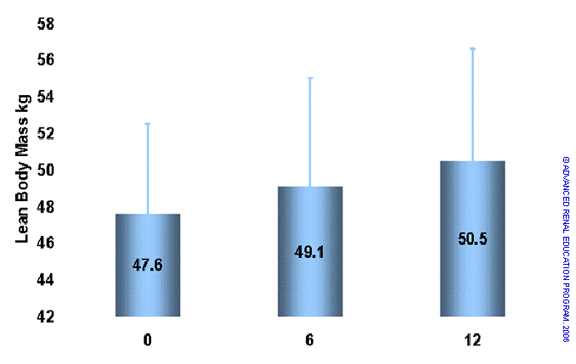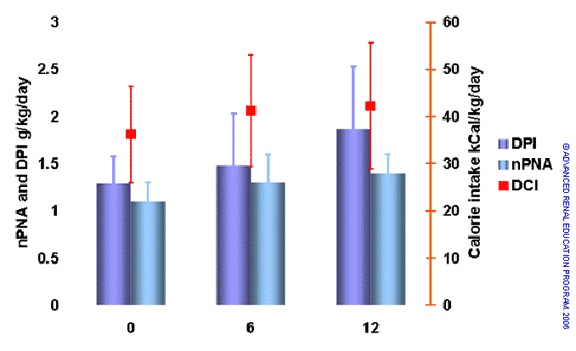Nutrition
The analysis of patient nutrition in response to increased dialysis frequency is difficult due to many confounding factors and most specifically, microinflammation. Determination of protein intake based on urea kinetic measurements is known to be mathematically coupled with dialysis dose. Interpretation of body composition data yielded by techniques such as bioimpedance and dual absorption X-radiometry (DEXA) are less than completely validated in patients with end-stage renal disease. In general, patients receiving adequate conventional dialysis experience improvement in appetite, protein and calorie intake and gain in non-fluid body weight within 6 to 12 months of starting treatment.
Galland et al. reported the nutritional response for 8 stable patients, established for between 1 and 17 years on maintenance conventional HD and converted to short (2-2.5 hours) daily HD (1). Diet was assessed by dietary history and dietary protein and calorie intake was calculated. Dietary protein intake was also calculated as nPNA from urea kinetic data. Other nutritional parameters included BMI and lean body mass (LBM). All nutritional indicators were significantly improved after 12 months of treatment at increased frequency.
 Nutritional parameters including nPNA, dietary protein and calorie intake (left) and lean body mass (right) during 12 months of short daily HD (1)
Nutritional parameters including nPNA, dietary protein and calorie intake (left) and lean body mass (right) during 12 months of short daily HD (1)
Nutrition was also examined in the London daily/nocturnal hemodialysis study (2). The data are far from conclusive and may be confounded by the more than 50% patient drop out in the lNHD group. Control patients showed no significant change in nPNA, serum albumin or mid-arm muscle area (MAMA, a measure of lean body mass). Initial response in sDHD patients with a rise in nPNA was not sustained, but they did show sustained gains in serum albumin and MAMA. No sustained improvement in nutritional parameters was found for lNHD patients. While interpretation should be guarded, it does appear that the improved nutritional status for sDHD is consistent with that reported by Galland (1). It will be important in future studies to examine both nutritional and inflammatory markers simultaneously for proper interpretation. The increased exposure of the patient to dialyzer membrane and dialysate when dialysis frequency is increased, could contribute to an increase in microinflammation. On the other hand, increased frequency of dialysis might more effectively remove mediators of inflammation and oxidation.
References:
-
Galland R, Traeger J, Arkouche W, Cleaud C, Delawari E, Fouque D. Short daily hemodialysis rapidly improves nutritional status in hemodialysis patients. Kidney Int 60:1555-1560, 2001
-
Spanner E, Suri R, Heidenheim AP, Lindsay RM. The impact of quotidian hemodialysis on nutrition. Am J Kidney Dis 42 (Suppl 1):s30-s35, 2003

